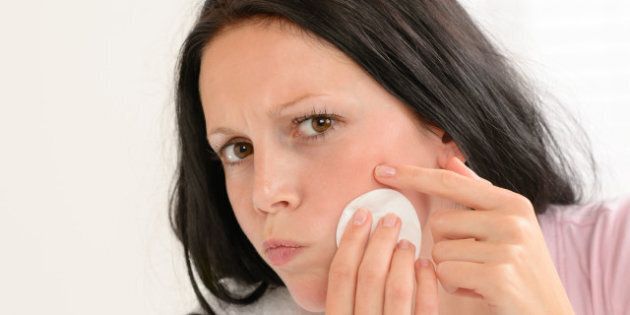
The emergence of pimples on the skin can be a frustrating experience for the majority of adolescents and up to 5% of the adult population that suffer through them. More colloquially known today as zits, these blemishes have both plagued and perplexed us for centuries. Research has focused on these sudden and for the most part unwanted uprisings, yet only in the last few years has a true cause -- and potential cure -- been found.
Not surprisingly, germs play a distinct role.
The formation of acne is a complicated process and may involve several factors such as overproduction of hormones, an imbalance in the amount of oils on the skin, and even diet. But the actual trigger has been shown to be a bacterium known as Propionibacterium acnes. The bacterium is actually a part of our normal microflora but can overgrow in hair follicles when there is an overabundance of a specific type of molecule known as a triglyceride . The bacteria are then able to grow to large enough numbers to trigger the immune system.
When that fight initiates, the skin and surrounding areas become inflamed, the immediate surroundings are filled with bacteria fighting white blood cells, and the normal process of skin peeling is halted. The overall effect is a bump that continues to grow until the battle is won or the person decides that enough is enough and uses a combination of pressure and friction to push the mass out from under the skin, better known as popping the zit. The latter however is not a recommended choice as damage from the pop may then lead to scarring or worse, other skin infections.
With the cause and process of acne elucidated, there have been a number of solutions marketed to help prevent and also remedy the affliction. Most have been chemically based, however other more involved procedures have been explored including lasers and light therapy as well as chemical peels. Yet in the last few years, there has been a different approach to controlling acne through a natural process of using good germs to control bad ones.
There have been several studies looking at how probiotics can help improve the look and feel of the skin and hair. A rather unique paper looked at how mice appeared to have shinier fur after eating yogurt; another examined the relationship between the gut, brain, and skin health. In light of these studies and others, the cosmetics market has become inundated with products for the face and skin featuring an array of different probiotics. Yet a group of researchers based out of UCLA published an article in Naturelast week that took the use of probiotics to an entirely different level.
In this study, the researchers took a closer look not at the usual species of good bacteria, but instead at the different types of P. acnes to see if there were any strains that could be used to help keep the skin safe. They found 10 different categories, known as ribotypes on the skin and of those, three stood out from the rest.
One ribotype, denoted RT6, was associated with healthy skin whereas two others, RT4 and RT5, were heavily involved in the formation of acne. The researchers went on to show that RT6 contained specific elements, awkwardly named Clustered Regularly Interspaced Short Palindromic Repeats (CRISPRs), which are known to help the immune system fight off infections. Overall, the results suggested that an imbalance of RT4 and 5 might lead to higher incidences of acne while RT6 might be a prime candidate for topical use to help prevent blemishes.
The research is preliminary at best and there needs to be more work on the different ribotypes to learn whether or not acne can be prevented by a probiotic. The authors even state that there are many other factors involved that need to be taken into consideration. But to provide backing to this theory, another paper published last month in PLOS ONE has shown that P. acnes might be useful as a probiotic to prevent other skin infections such as Methicillin-Resistant Staphylococcus aureus (MRSA).
Over the coming months and years, probiotic creams to improve the look of skin will undoubtedly grow in numbers and reputation. There will be the usual array of adopters and detractors who will either bring a clearer light to the picture or, as with other natural health products, muddy the waters such that no one knows where to turn. However, thanks in part to the Nature study, there is hope that in the not too distant future, medically proven treatments will become available to help those who suffer and perhaps put an end to acne forever.
